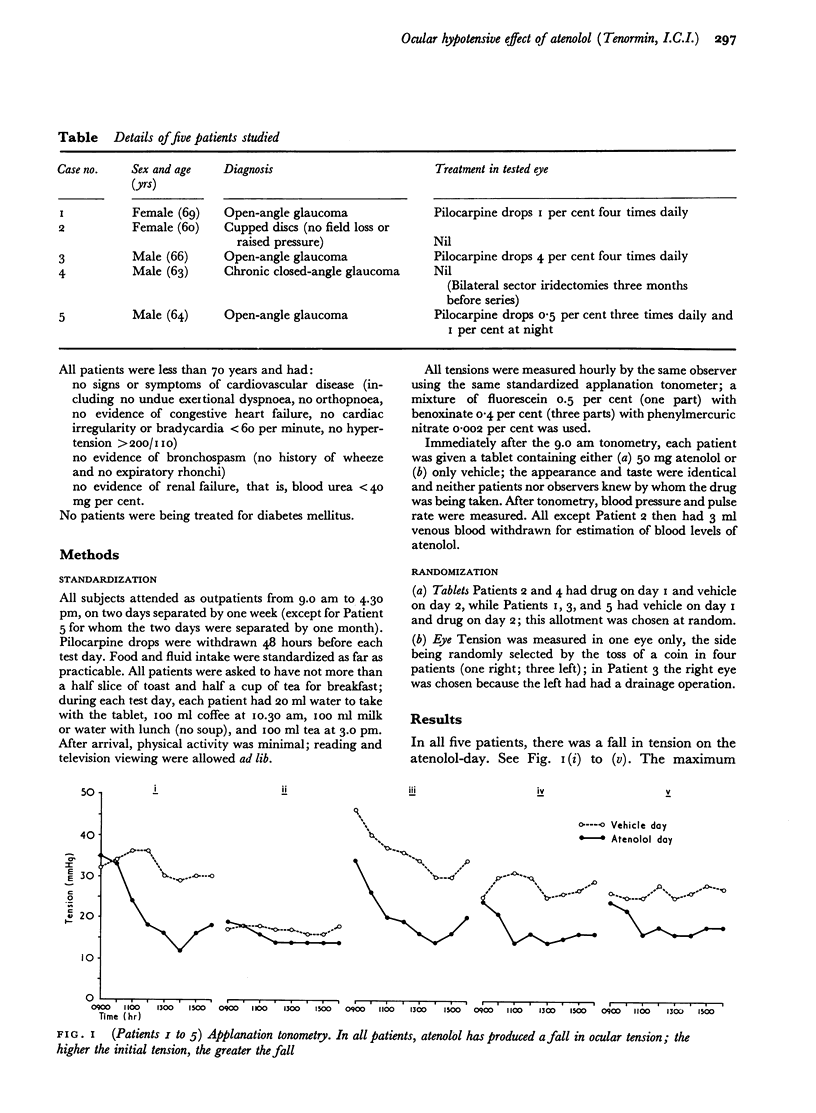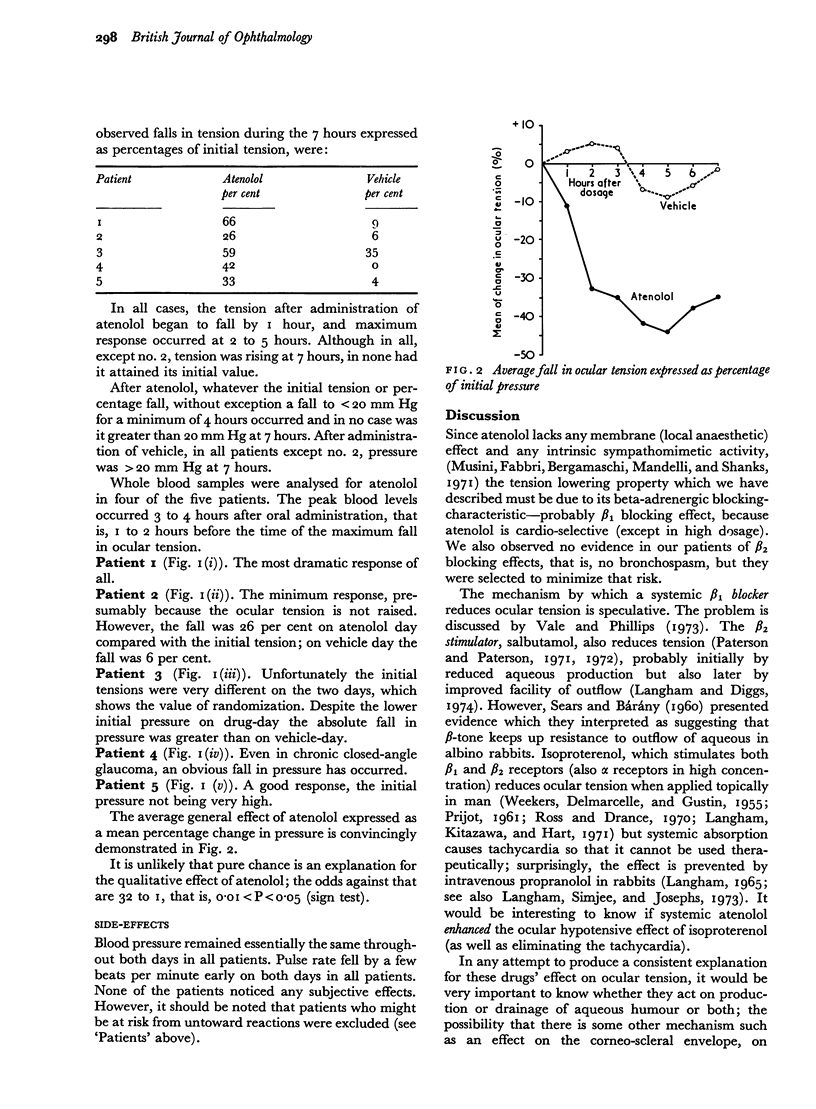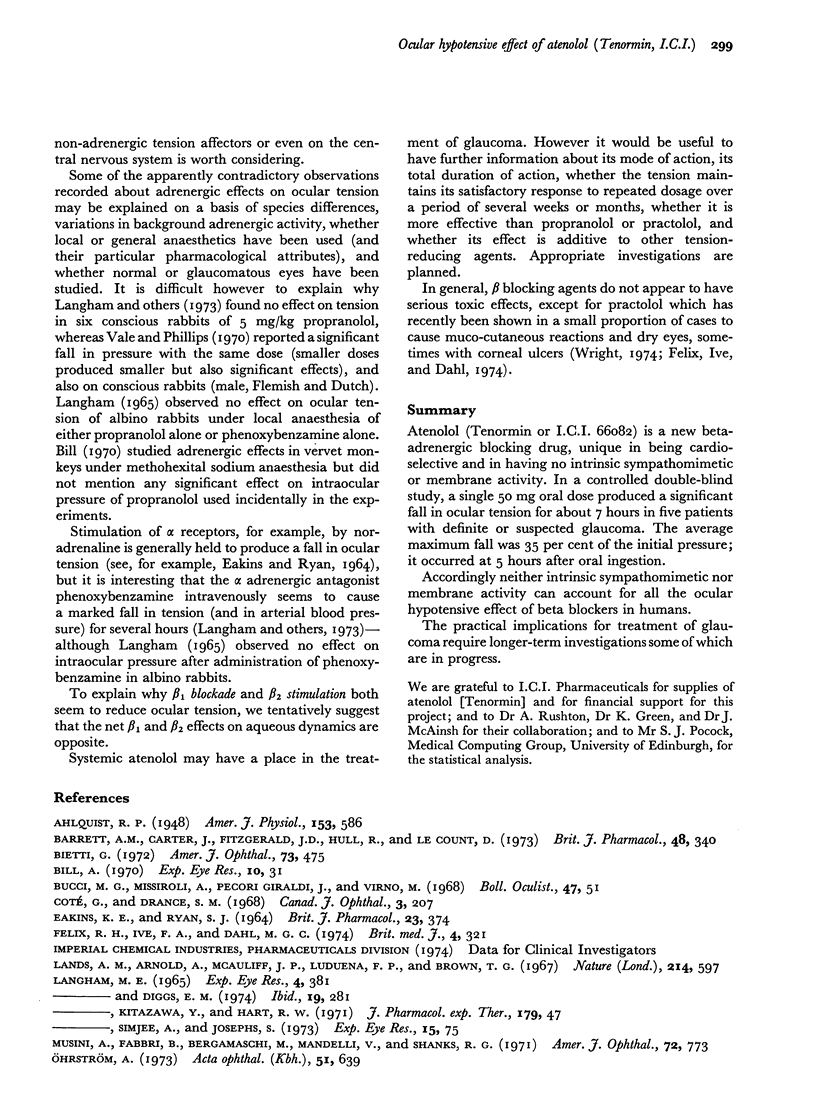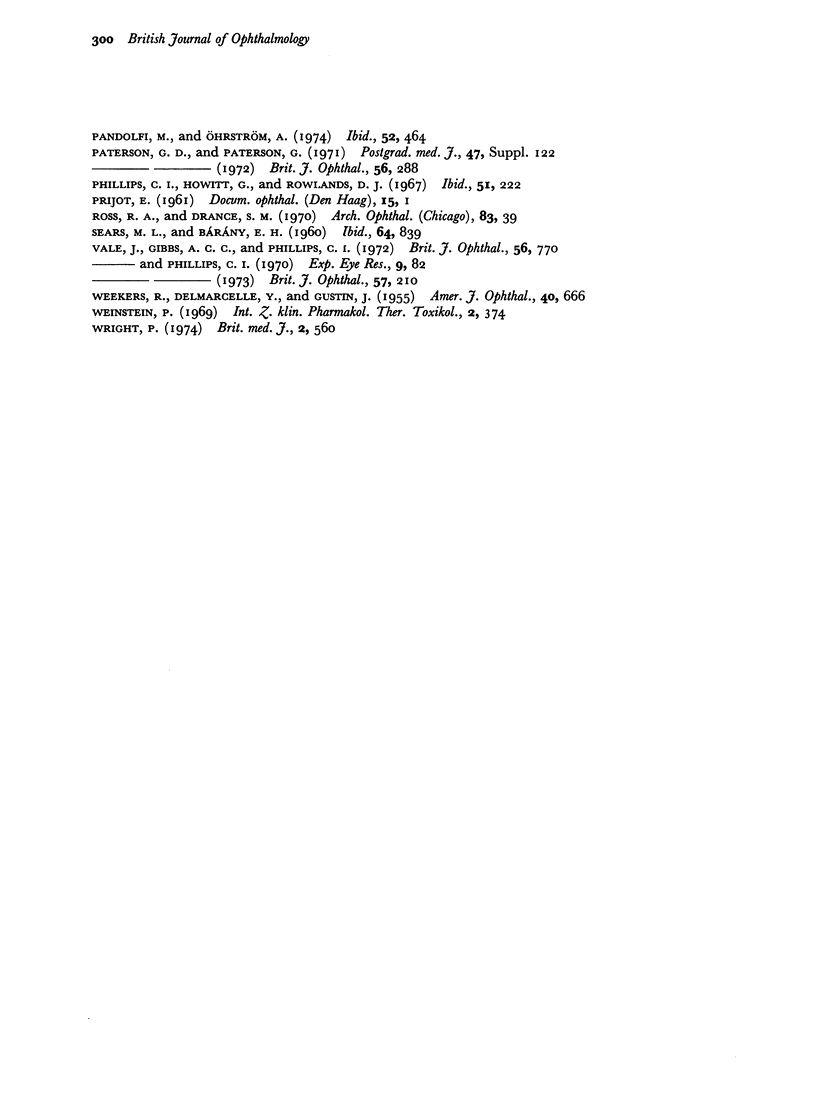Abstract
Atenolol (Tenormin or I.C.I. 66082) is a new beta-adrenergic blocking drug, unique in being cardio-selective and in having no intrinsic sympathomimetic or membrane activity. In a controlled double-blind study, a single 50 mg oral dose produced a significant fall in ocular tension for about 7 hours in five patients with definite or suspected glaucoma. The average maximum fall was 35 per cent of the initial pressure; it occurred at 5 hours after oral ingestion. Accordingly neither intrinsic sympathomimetic nor membrane activity can account for all the ocular hypotensive effect of beta blockers in humans. The practical implications for treatment of glaucoma require longer-term investigations some of which are in progress.
Full text
PDF




Selected References
These references are in PubMed. This may not be the complete list of references from this article.
- Bietti G. Recent experimental, clinical, and therapeutic research on the problems of intraocular pressure and glaucoma. Am J Ophthalmol. 1972 Apr;73(4):475–500. doi: 10.1016/0002-9394(72)90001-3. [DOI] [PubMed] [Google Scholar]
- Bill A. Effects of norepinephrine, isoproterenol and sympathetic stimulation on aqueous humour dynamics in vervet monkeys. Exp Eye Res. 1970 Jul;10(1):31–46. doi: 10.1016/s0014-4835(70)80006-9. [DOI] [PubMed] [Google Scholar]
- Coté G., Drance S. M. The effect of propranolol on human intraocular pressure. Can J Ophthalmol. 1968 Jul;3(3):207–212. [PubMed] [Google Scholar]
- EAKINS K. E., RYAN S. J. THE ACTION OF SYMPATHOMIMETIC AMINES ON THE OUTFLOW OF AQUEOUS HUMOUR FROM THE EYE. Br J Pharmacol Chemother. 1964 Oct;23:374–382. doi: 10.1111/j.1476-5381.1964.tb01593.x. [DOI] [PMC free article] [PubMed] [Google Scholar]
- Felix R. H., Ive F. A., Dahl M. G. Cutaneous and ocular reactions to practolol. Br Med J. 1974 Nov 9;4(5940):321–324. doi: 10.1136/bmj.4.5940.321. [DOI] [PMC free article] [PubMed] [Google Scholar]
- Lands A. M., Arnold A., McAuliff J. P., Luduena F. P., Brown T. G., Jr Differentiation of receptor systems activated by sympathomimetic amines. Nature. 1967 May 6;214(5088):597–598. doi: 10.1038/214597a0. [DOI] [PubMed] [Google Scholar]
- Langham M. E., Kitazawa Y., Hart R. W. Adrenergic responses in the human eye. J Pharmacol Exp Ther. 1971 Oct;179(1):47–55. [PubMed] [Google Scholar]
- Langham M. E., Simjee A., Josephs S. The alpha and beta adrenergic responses to epinephrine in the rabbit eye. Exp Eye Res. 1973 Jan 1;15(1):75–84. doi: 10.1016/0014-4835(73)90192-9. [DOI] [PubMed] [Google Scholar]
- Langham M. E. The response of the pupil and intraocular pressure of conscious rabbits to adrenergic drugs following unilateral superior cervical ganglionectomy. Exp Eye Res. 1965 Dec;4(4):381–389. doi: 10.1016/s0014-4835(65)80056-2. [DOI] [PubMed] [Google Scholar]
- Musini A., Fabbri B., Bergamaschi M., Mandelli V., Shanks R. G. Comparison of the effect of propranolol, lignocaine, and other drugs on normal and raised intraocular pressure in man. Am J Ophthalmol. 1971 Oct;72(4):773–781. doi: 10.1016/0002-9394(71)90017-1. [DOI] [PubMed] [Google Scholar]
- Pandolfi M., Ohrström A. Treatment of ocular hypertension with oral beta-adrenergic blocking agents. Acta Ophthalmol (Copenh) 1974;52(4):464–467. doi: 10.1111/j.1755-3768.1974.tb01757.x. [DOI] [PubMed] [Google Scholar]
- Phillips C. I., Howitt G., Rowlands D. J. Propranolol as ocular hypotensive agent. Br J Ophthalmol. 1967 Apr;51(4):222–226. doi: 10.1136/bjo.51.4.222. [DOI] [PMC free article] [PubMed] [Google Scholar]
- Ross R. A., Drance S. M. Effects of topically applied isoproterenol on aqueous dynamics in man. Arch Ophthalmol. 1970 Jan;83(1):39–46. doi: 10.1001/archopht.1970.00990030041007. [DOI] [PubMed] [Google Scholar]
- SEARS M. L., BARANY E. H. Outflow resistance and adrenergic mechanisms. Effects of sympathectomy, N-(2-chloroethyl) dibenzylamine hydrochloride (dibenamine) and dichloroiso-proterenol on the outflow resistance of the rabbit eye. Arch Ophthalmol. 1960 Dec;64:839–848. doi: 10.1001/archopht.1960.01840010841004. [DOI] [PubMed] [Google Scholar]
- Vale J., Gibbs A. C., Phillips C. I. Topical propranolol and ocular tension in the human. Br J Ophthalmol. 1972 Oct;56(10):770–775. doi: 10.1136/bjo.56.10.770. [DOI] [PMC free article] [PubMed] [Google Scholar]
- WEEKERS R., DELMARCELLE Y., GUSTIN J. Treatment of ocular hypertension by adrenalin and diverse sympathomimetic amines. Am J Ophthalmol. 1955 Nov;40(5 Pt 1):666–672. doi: 10.1016/0002-9394(55)91493-8. [DOI] [PubMed] [Google Scholar]
- Weinstein P. Receptor paralyzing agents applied in the treatment of glaucoma simplex. Int Z Klin Pharmakol Ther Toxikol. 1969 Oct;2(4):374–375. [PubMed] [Google Scholar]
- Wright P. Letter: Skin reactions to practolol. Br Med J. 1974 Jun 8;2(5918):560–560. doi: 10.1136/bmj.2.5918.560. [DOI] [PMC free article] [PubMed] [Google Scholar]


